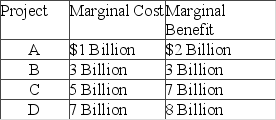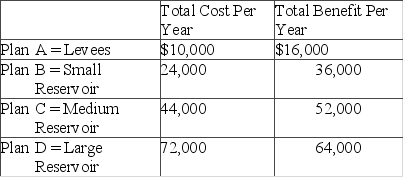A) frozen yogurt
B) bubble gum
C) microwave popcorn
D) courts of law
F) A) and C)
Correct Answer

verified
Correct Answer
verified
True/False
The optimal quantity of a public good occurs where the marginal benefit of the citizen who has the highest preference for the good just equals the good's marginal cost.
B) False
Correct Answer

verified
Correct Answer
verified
Multiple Choice
The marginal benefit to society of reducing pollution declines with increases in pollution abatement because of the law of
A) increasing costs.
B) diminishing returns.
C) diminishing marginal utility.
D) conservation of matter and energy.
F) B) and C)
Correct Answer

verified
Correct Answer
verified
Multiple Choice
Professional buyers of antiques often have more information about the value of antique objects than do the sellers. This illustrates
A) the principal-agent problem.
B) the moral hazard problem.
C) the free-rider problem.
D) asymmetric information.
F) B) and C)
Correct Answer

verified
Correct Answer
verified
Multiple Choice
Assume that a government is considering a new social program and may choose to include in this program one of four progressively larger projects. The marginal cost and the marginal benefits of each of the four projects are given in the table below.  Suppose that the government chooses to do project C What is the total cost and total benefit of doing project C?
Suppose that the government chooses to do project C What is the total cost and total benefit of doing project C?
A) Total cost is $5 billion, and total benefit is $7 billion.
B) Total cost is $4 billion, and total benefit is $7 billion.
C) Total cost is $9 billion, and total benefit is $12 billion.
D) Total cost is $16 billion, and total benefit is $20 billion.
F) C) and D)
Correct Answer

verified
Correct Answer
verified
Multiple Choice
The following data are for a series of increasingly extensive flood-control projects.  For Plan D marginal costs and marginal benefits are
For Plan D marginal costs and marginal benefits are
A) $72,000 and $64,000, respectively.
B) $28,000 and $12,000, respectively.
C) $24,000 and $18,000, respectively.
D) $16,000 and $28,000, respectively.
F) C) and D)
Correct Answer

verified
Correct Answer
verified
Multiple Choice
Suppose an insurance company decided to offer divorce insurance. Based on the concept of moral hazard, economists would expect
A) all married couples to purchase divorce insurance.
B) no married couples to purchase divorce insurance.
C) mostly the couples with marital problems to purchase divorce insurance.
D) the divorce rate to decrease.
F) A) and C)
Correct Answer

verified
Correct Answer
verified
Multiple Choice
External benefits in consumption refer to benefits accruing to
A) those who are selling the product to the consumers.
B) those who bought and consumed the product.
C) those other than the ones who consumed the product.
D) those who are consuming the product abroad.
F) B) and D)
Correct Answer

verified
Correct Answer
verified
Multiple Choice
What two conditions must hold for a competitive market to produce efficient outcomes?
A) Demand curves must reflect all costs of production, and supply curves must reflect consumers' full willingness to pay.
B) Supply curves must reflect all costs of production, and demand curves must reflect consumers' full willingness to pay.
C) Firms must minimize production costs, and consumers must minimize total expenditures.
D) Firms must maximize profits, and consumers must all pay prices equal to their maximum willingness to pay.
F) B) and D)
Correct Answer

verified
Correct Answer
verified
Multiple Choice
The "too big to fail" policy of the Fed, whereby some banks are bailed out if they are in danger of failing because they are too big and could bring the system down, leads to which of the following problems?
A) adverse selection
B) externalities
C) moral hazard
D) public goods
F) None of the above
Correct Answer

verified
Correct Answer
verified
Multiple Choice
Private firms can hardly produce a public good profitably because of
A) liability rules and lawsuits.
B) the free-rider problem.
C) shortages and surpluses.
D) moral hazard and adverse selection.
F) C) and D)
Correct Answer

verified
Correct Answer
verified
True/False
When critics of unemployment insurance claim that some of the unemployed are not exerting much effort to find jobs because of the unemployment benefits, they are referring to the moral hazard problem.
B) False
Correct Answer

verified
Correct Answer
verified
Multiple Choice
Which of the following statements is not true?
A) Some public goods are paid for by private philanthropy.
B) Private provision of public goods is usually unprofitable.
C) The free-rider problem results from the characteristics of nonrivalry and nonexcludability.
D) Public goods are only provided by government.
F) A) and C)
Correct Answer

verified
Correct Answer
verified
Multiple Choice
Demand-side market failures occur when
A) demand curves don't reflect consumers' full willingness to pay for a good or service.
B) demand curves don't reflect the full cost of producing a good or service.
C) government imposes a tax on a good or service.
D) a good or service is not produced because no one wants it.
F) All of the above
Correct Answer

verified
Correct Answer
verified
Multiple Choice
When a competitive market achieves allocative efficiency, it implies that
A) the marginal benefit of having the product is greater than the marginal cost.
B) the buyers are getting the maximum consumer surplus from the product.
C) the combined consumer and producer surplus is maximized.
D) the quantity demanded is lower than the quantity supplied.
F) A) and B)
Correct Answer

verified
Correct Answer
verified
Multiple Choice
Which of the following situations is not an example of market failure?
A) Ben's Department Store cannot charge passers-by for using the sidewalk outside the store.
B) Ben cannot afford to buy a high-end Mercedes Benz luxury car.
C) Ben's Place is the only restaurant in town, and thus he has significant power to set menu prices.
D) Ben's Industries is dumping its wastewater into the unregulated river behind the factory.
F) A) and D)
Correct Answer

verified
Correct Answer
verified
Multiple Choice
Some sellers of used cars provide warranties to buyers, with the aim of reassuring buyers that the car is of good quality. These warranties help reduce the chance of what occurring?
A) negative externalities
B) adverse selection
C) spillover benefits
D) moral hazard
F) B) and C)
Correct Answer

verified
Correct Answer
verified
Multiple Choice
Where there is asymmetric information between buyers and sellers,
A) product shortages will occur at the equilibrium price.
B) product surpluses will occur at the equilibrium price.
C) markets can produce inefficient outcomes.
D) markets will fail due to the "free-rider problem."
F) C) and D)
Correct Answer

verified
Correct Answer
verified
Multiple Choice
Because the federal government typically provides disaster relief to farmers, many farmers do not buy crop insurance even through it is federally subsidized. This illustrates
A) the adverse selection problem.
B) the moral hazard problem.
C) the special interest effect.
D) logrolling.
F) B) and D)
Correct Answer

verified
Correct Answer
verified
True/False
A moral hazard problem occurs before a transaction-when people alter their behavior before they sign a contract, imposing costs on the other party.
B) False
Correct Answer

verified
Correct Answer
verified
Showing 21 - 40 of 235
Related Exams